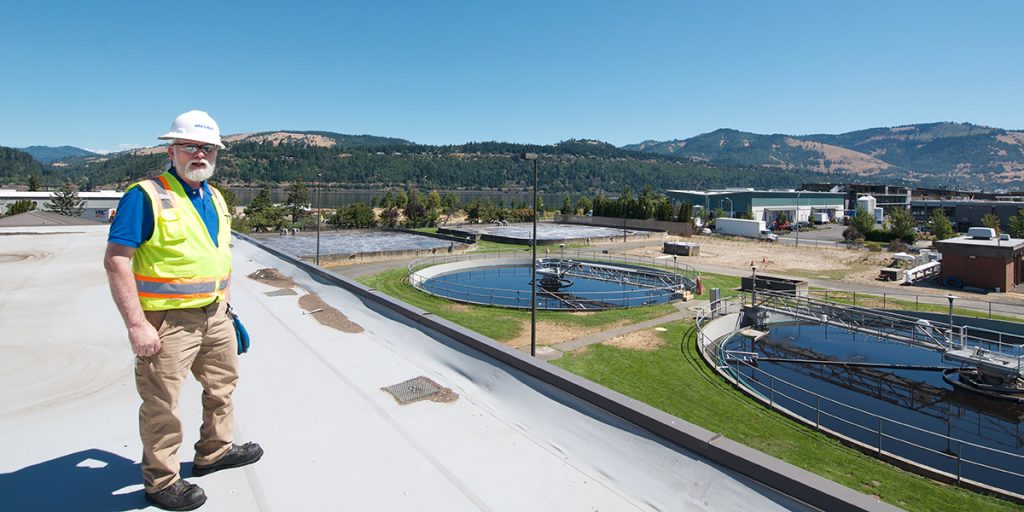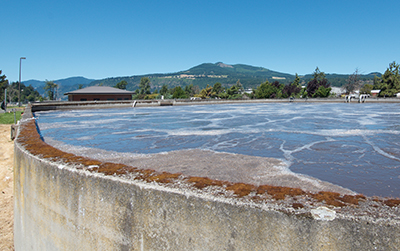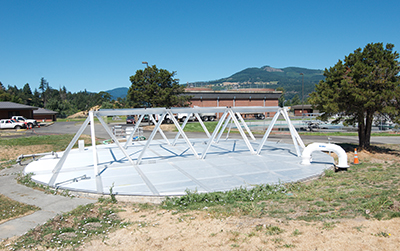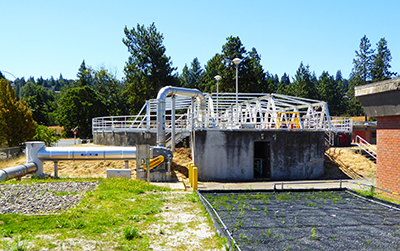
Solutions pursued at Wastewater Treatment Plant
Spring efforts to substantially improve odor control at the City’s ecologically-friendly Wastewater Treatment Plant, located on City property on the far west end of Hood River’s waterfront, appear to be successful due to a combination of major operational modifications and biological remediation.
In the past couple years, strong aromas were generally more offensive on hot, windless days which generally occur in summer months when waterfront use is at its highest.
According to Louie Hooks, operations manager at the Wastewater Treatment Plant (WWTP), one component of recent odor concerns was the growth of bacteria in the activated sludge tanks along with high organic loadings from plant influent. Biological remediation, or “bio-rem,” has been partially effective in scrubbing out hydrogen sulfide, a byproduct of decomposing septic waste that produces a rotten-egg smell.
Odor control projects

Flow has been reversed to two aeration basins where delicate ecosystems of bacteria and oxygen must be maintained. A spring 2018 project included covering the activated sludge tank and the aeration basin splitter box (which controls how much waste goes to each aeration tank) where most of the foul air was emitting. Now that those containers are capped, covered foul air can be diverted to an inground filtering system. Air under the cover is pumped into a bio-rem system, sprayed with water and released beneath in-ground organic matter that remediates foul air.
“That improvement had the biggest impact I’ve witnessed in odor control at the treatment plant,” declares Public Works Director Mark Lago.
The newly covered activated sludge tank holds foul air in to be treated in a second bio-rem chamber.

The Hood River plant’s odor control is all natural, biological treatments without chemicals. “It’s a complex balance of controlling bad bacteria and maintaining an ideal environment for friendly bacteria,” Hooks relays. “Bacteria involved in this system are very temperamental organisms requiring abundant food and warmth (98-degree temperature is optimum). When their environment is ideal, they will eat up the smelly hydrogen sulfide and in exchange produce methane we use to power the boiler,” Hooks describes. “If the bacteria aren’t happy and don’t produce adequate methane, we have to purchase costly natural gas for the burner.”
With the activated sludge take and splitter box now covered, a second inground diffused air system has been created to scrub odors before releasing air back into the atmosphere.

Finally, an engineering feat has also contributed to the recent odor control project. By reversing the intake order for biological treatment of wastewater to the western aeration basin first, followed by a second treatment in the eastern aeration basin, a decrease in noticeable smell has occurred.
Filamentous bacteria, a type of bacteria common in wastewater treatment systems, live throughout the aeration basins. In small amounts, they are beneficial to a biomass. In high amounts they can be detrimental, causing sludge bulking or floating solids that upset activated sludge systems. When oxygen reaches certain levels, this population can hide and then grow rapidly, affecting the capacity of solids to settle. Although it’s possible to maintain good effluent under these conditions, more offensive odors may result when bacteria consume available oxygen in the system.
History of the WTTP
The deceivingly large plant is located on eight acres of City property at the west end of the Hood River waterfront where odor control issues have become more disturbing with recent growth in nearby recreational, light industrial and commercial uses.
Hooks has worked at Hood River’s plant since 1991, where operations have been managed by CH2M, now JACOBS, since 1983. Recently Jacobs acquired CH2M, bringing the global engineering contractor to more than 70,000 employees strong. Jacobs has seven employees at Hood River’s WWTP, and the same crew manages treatment plants in Cascade Locks and Stevenson.
City seeks sustainability of its bio-solid waste program
A byproduct of the City’s treatment process is stabilized, inert bio-solids rich in nutrients, particularly nitrogen and phosphates. The city has historically relied on the local agriculture industry to receive these bio-solids for land application for crop fertilization. Growing population results in growing waste. The City has an increasing supply of bio-solids, but a decreased local demand for this product that is jeopardizing the ecologically friendly, fiscally responsible and environmentally sustainable practice of maintaining a mutually beneficial bio-solids program with local farmers.
CH2M became involved in the Hood River WWTP while completing a 1974 upgrade. The City decided to contract operations of the plant several years later due to cost savings, technical aspects of operations and state certification requirements for each employee. The plant treats wastewater per Oregon Dept. of Environmental Quality (DEQ) requirements prior to discharging it into the Columbia River.
Prior to the ’74 upgrade, the old plant consisted of a sludge holding tank, manual bar-screen and a mechanical grit removal system, and a trickling filter and spray of organic media in contact chambers. At that time, the Columbia River was closer to the plant prior to the Port of Hood River industrial park landfill project on the western waterfront.
Complaints of offensive odors transmitted by the WWTP began in the late 1990s, initially caused by an old burner intended to reduce excess gas. It required manual lighting, so when it failed after hours it would release foul odor into the atmosphere.
The antiquated plant underwent another major upgrade in 2000. Hooks oversaw that upgrade when the elevated primary clarifier was installed that separates oil and grease, allowing solids to sink to the bottom to be fed to bacterial organisms that produce methane gas in the digesters. The millennial upgrade also included a new solids building (which has its own odor control) and new headworks building where waste influent is screened, removed of grit and pumped to the primary clarifier.
In 2010, as waterfront employment populations and park / trail users increased, a major odor control project was completed to cover the primary clarifier and install the original underground scrubber system to remediate foul air. Despite all the improvements, problems and solutions for this complex treatment plant, with average daily inflows of one million gallons or more, will continue to arise. Hopes are that equally successful environmentally sustainable solutions will resolve future issues.
Please consider signing up HERE to receive quarterly Emails of future editions of Hood River City Connect.
Si le gusta lo que acaba de leer, considere inscribirse AQUI para recibir correos electrónicos trimestrales de futuras ediciones de Hood River City Connect.
